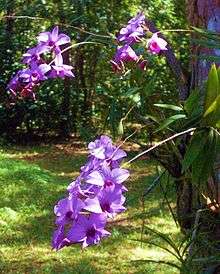Vappodes phalaenopsis
| Cooktown Orchid | |
|---|---|
 | |
| Scientific classification | |
| Kingdom: | Plantae |
| (unranked): | Angiosperms |
| (unranked): | Monocots |
| Order: | Asparagales |
| Family: | Orchidaceae |
| Subfamily: | Epidendroideae |
| Genus: | Dendrobium |
| Species: | D. bigibbum |
| Binomial name | |
| Dendrobium bigibbum Lindl. | |
| Synonyms | |
| |
The Cooktown Orchid (Vappodes phalaenopsis) has been the floral emblem of Queensland since 19 November 1959.[1][2] It was first described in 1880 as Dendrobium phalaenopsis, then included in Dendrobium bigibbum,
More recently, the D. bigibbum complex has been separated into the genus Vappodes.[3] The new name of Vappodes phalaenopsis has now been accepted by the World Checklist of Monocotyledons, as a synonym of Dendrobium bigibbum Lindl., Paxton's Fl. Gard. 3: 25 (1852).[4]
Description
This orchid is closely related to several other species of flowers known as vappodes now listed in Vappodes and readily forms hybrids, which are now described under the "named hybrid genus" XVappaculum.[5]
The colour of the flowers varies from pinkish-mauve to lavender or purple and sometimes almost white, with the base of the labellum being a much darker purple.[6][7]
The plants can grow up to 80 cm in height. The flowers are on canes 10–40 cm long. Flowering time is usually in the dry season between March and July;[8][9] but sometimes all year in commercial cultivation. The flowers are on racemes 200–400 mm long and are usually lilac-purple, but can be bluish or even white and sometimes pinkish with darker purple labellum without a white spot.[8]
Habitat
It lives in a wide variety of habitats ranging from coastal scrub on trees and rocks, to mangroves, riverine vegetation, rainforest, vine thickets, gullies in open forest and even swamps.[8] It used to be prolific around Cooktown but is now rare in the wild, due to over-collecting by commercial collectors. It is now listed as vulnerable by the EPBC Act.[10]
Range
It occurs naturally in a limited area from the Endeavour River Valley, west of Cooktown, south to the Font Hills, west of Mount Molloy, in far northern Queensland.[8]
Cultivation and uses
Likes a dry, sunny position with a minimum of watering and a temperature that does not fall below 13 °C. Needs a bush-house in cooler climates.[6] Cultivated plants often have much larger flowers than those in the wild.[7]
Queensland State Floral Emblem
Queensland, in preparation for its 1959 Centenary, sought advice what native species would be a good floral emblem. Specifically, the government was looking for an easily grown species found only in Queensland, which was decorative, distinctive, and close to the State colour, maroon. The Cooktown Orchid, which meets these criteria, was one of the four initial suggestions, the others being the Red Silky Oak (Grevillea banksii), the Umbrella Tree (Brassaia actinophylla (now Schefflera actinophylla), and the Wheel-of-Fire (Stenocarpus sinuatus). The Courier-Mail, a Brisbane newspaper, sought additional suggestions from its readers, and compiled a list of 13 possibilities. In a public poll, the Cooktown Orchid came in first place, the Red Silky Oak in second, and poinsettia (Euphorbia pulcherrima), already the floral emblem of the capital city Brisbane, came in third.[11]
.jpg)
References
- ↑ "Badge, Arms, Floral and Other Emblems of Queensland Act 1959: 2 Floral emblem" (PDF). Office of Queensland Parliamentary Counsel. Reprinted 1997-12-10. p. 5. Retrieved 2006-09-11. Check date values in:
|date=(help) Not an authorised copy. - ↑ Online Australian Plant Census
- ↑ A Complete Guide to Native Orchids of Australia Including the Island Territories, pp. 416-418. David L. Jones. (2006) Reed New Holland. Sydney, Auckland, London, Cape Town. ISBN 1-877069-12-4.
- ↑ "WCSP". World Checklist of Selected Plant Families. Retrieved 2010. Check date values in:
|access-date=(help) - ↑ A Complete Guide to Native Orchids of Australia Including the Island Territories, pp. 418-419. David L. Jones. (2006) Reed New Holland. Sydney, Auckland, London, Cape Town. ISBN 1-877069-12-4.
- 1 2 Scarth-Johnson, Vera. 2000. National Treasures: Flowering plants of Cooktown and Northern Australia. Vera Scarth-Johnson Gallery Association. ISBN 0-646-39726-5 (pbk); ISBN 0-646-39725-7 Limited Edition leather-bound
- 1 2 Useful information on the Cooktown Orchid
- 1 2 3 4 A complete Guide to Native Orchids of Australia, including the island territories, p. 418. David L. Jones. 2006. New Holland Publishers, Frenchs Forest, N.S.W. 2086 Australia. ISBN 1-877069-12-4.
- ↑ Scarth-Johnson, Vera. 2000. National Treasures: Flowering plants of Cooktown and Northern Australia, p. 153. Vera Scarth-Johnson Gallery Association. ISBN 0-646-39726-5 (pbk); ISBN 0-646-39725-7 Limited Edition leather-bound]
- ↑
- ↑ Boden, Anne (1995). "Cooktown Orchid (Dendrobium phalaenopsis) – Floral Emblem of Queensland". Floral Emblems of Australia. Australian National Botanic Gardens. Originally published by AGPS. Retrieved 2006-09-08.
External links
- More illustrations of the Cooktown Orchid by Vera Scarth-Johnson
- Dendrobium Species Culture: Part 2 – Dendrobium phalaenopsis
 Media related to Vappodes phalaenopsis at Wikimedia Commons
Media related to Vappodes phalaenopsis at Wikimedia Commons
